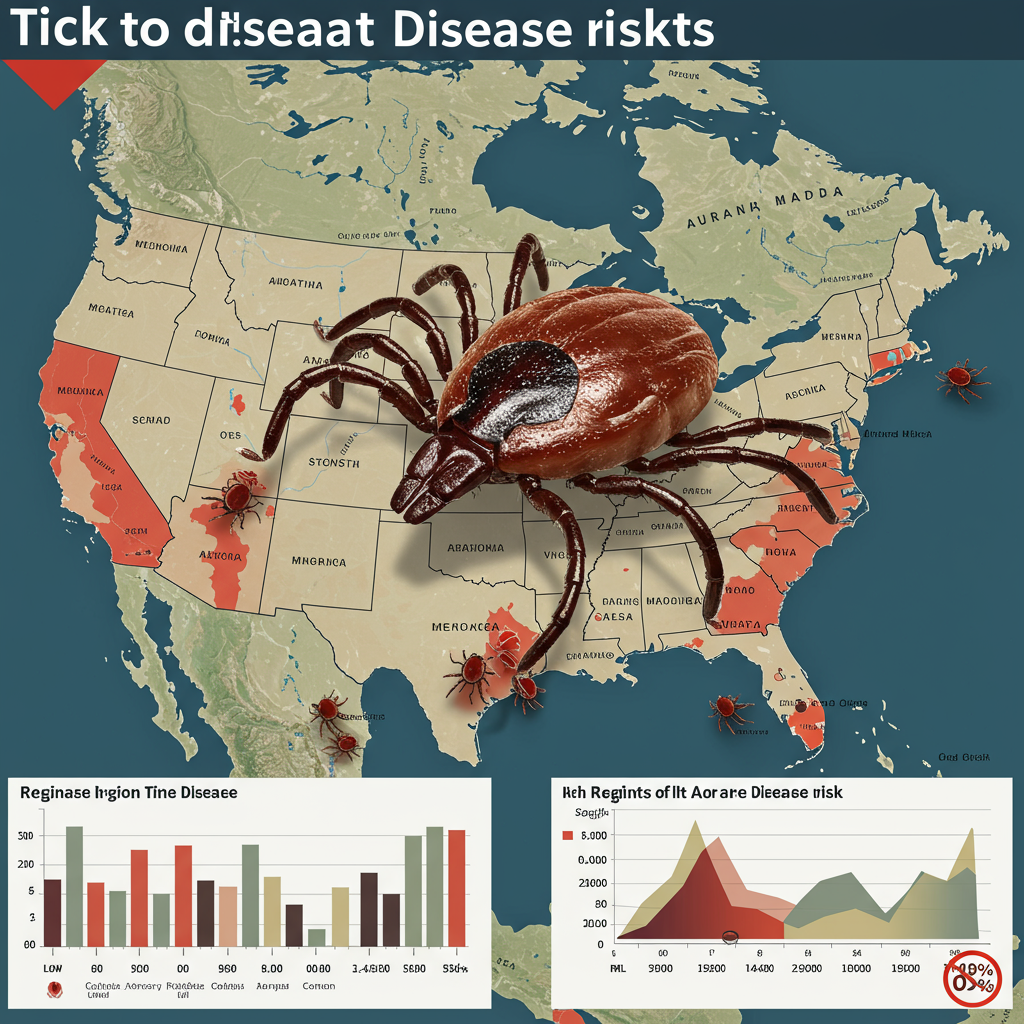tick-borne illnesses are becoming increasingly common across the United States, presenting varied risks depending on where you live or travel. Experts are noting early signs that 2024 could see high numbers of tick encounters; CDC data showed emergency care visits for tick bites in May 2024 reached their highest point since 2019. While ticks are found in every U.S. state, and millions of people experience bites each year, the specific dangers they pose can differ significantly by geographic area. This guide explores the diverse landscape of tick-borne diseases across U.S. regions, providing essential information on prevention and action to help you stay safe.
Ticks, though tiny, are powerful vectors capable of transmitting over a dozen different disease-causing agents. These can include bacteria, viruses, parasites, toxins, and allergens, leading to illnesses that range from mild discomfort to severe, life-threatening conditions. Unlike mosquitoes, which can transmit pathogens almost instantly, most ticks need to be attached and feeding for several hours or even days before they can successfully transmit an infectious dose of a pathogen. This unique characteristic offers a critical window for intervention: prompt detection and removal are your best defense against falling ill.
Understanding Tick Behavior and Prevention
Ticks are not fast movers and typically wait in tall grasses, brush, and leaf litter for hosts to brush past. They often hitch a ride on humans, pets, or other animals before finding a place to bite. Because ticks require this attachment period for disease transmission, proactive steps are highly effective in reducing risk.
Epidemiologists and tick experts recommend several key preventative measures whenever you spend time outdoors, especially in wooded or grassy areas:
Essential Tick Prevention Strategies
Perform Regular Tick Checks: After being outside, thoroughly inspect yourself, your children, and your pets. Pay close attention to areas like underarms, behind knees, in hair, around ears, and inside the belly button.
Prompt Removal is Key: If you find an attached tick, remove it as quickly as possible using fine-tipped tweezers. Grasp the tick close to the skin’s surface and pull straight up with steady, even pressure. Clean the bite area and your hands afterward.
Stay on Trails: When hiking or walking, stick to the center of well-maintained trails. Avoid walking through thick brush, tall grass, and leaf piles where ticks are likely waiting.
Treat Clothing and Gear: Use products containing permethrin on clothing, boots, and camping gear. Permethrin repels and kills ticks on contact and can provide protection for multiple washings. Note: Permethrin is for clothing and gear, not for direct skin application.
Use EPA-Registered Repellents: Apply insect repellents containing active ingredients like DEET, picaridin, IR3535, Oil of Lemon Eucalyptus (OLE), Para-menthane-diol (PMD), or 2-undecanone to exposed skin. Always follow product instructions and use an EPA-registered repellent for proven effectiveness against ticks.
Protect Your Pets: Pets are highly susceptible to tick bites and can carry ticks indoors. Consult your veterinarian about appropriate tick prevention products for your dog or cat, such as collars, spot-ons, or oral medications. Regularly check pets for ticks, especially after outdoor excursions.
Maintain Your Yard: Keep grass mowed short and remove leaf litter, brush, and other debris that provide tick habitats in your yard.
Tick Risks Vary by Geographic Region
The type of tick species present and the pathogens they carry differ significantly across the United States. This leads to distinct regional risk profiles for various tick-borne diseases. The CDC broadly categorizes the country into three main regions based on tick activity and associated illnesses.
The Northern Region: High Risk and Lyme Central
The Northeast, Mid-Atlantic, and Upper Midwest experience the highest incidence of tick bites, with nearly 20% of people reporting bites annually. This vast area is considered a high-risk zone, particularly for Lyme disease, which is the most common tick-borne illness nationwide, affecting an estimated 470,000 people each year.
In this region, the blacklegged tick (Ixodes scapularis), often called the deer tick, is the primary culprit for transmitting Lyme disease. A significant percentage of these ticks carry the Borrelia burgdorferi bacteria, with studies showing up to 30% of nymphal ticks and 60% of adult ticks in this area may be infected. While Lyme disease is the dominant threat, ticks in the North can also carry pathogens causing Anaplasmosis, Babesiosis, and Relapsing Fever, though these are far less common, found in roughly 2% to 6% of ticks. Regional tick populations here tend to crawl higher on vegetation, increasing contact likelihood with humans.
The Southern Region: Different Threats, Lower Incidence
Across the Central and Southeastern states, including Texas, approximately 13% of residents report tick bites. While tick encounters are less frequent than in the North, this region presents its own set of prevalent tick-borne concerns.
Key diseases here include Ehrlichiosis, Spotted Fever Rickettsioses (like Rocky Mountain Spotted Fever, though it’s found in other regions too), and the allergic condition known as Alpha-gal Syndrome. Alpha-gal Syndrome is a unique reaction to red meat allergens transmitted by specific tick bites, notably the Lone Star tick (Amblyomma americanum), which is common in the South. Experts suggest the slightly lower bite incidence in the South might be linked to differences in tick behavior; ticks in this area often remain closer to the ground level compared to their Northern counterparts.
The Western Region: Fewer Bites, Varied Risks
Western states, including California, report the lowest incidence of tick bites, affecting around 6% of the population. However, this does not mean the region is risk-free.
Individuals in the West can still encounter ticks and contract tick-borne illnesses. Some diseases present in Western states include Lyme disease, Anaplasmosis, and Rocky Mountain Spotted Fever. While less common than in the North, awareness and prevention remain important for anyone spending time outdoors in this region.
What to Do If You Get Bitten
Finding a tick attached to you can be alarming, but taking prompt action can significantly reduce your risk of disease. The first step is always to remove the tick as quickly and safely as possible using fine-tipped tweezers as described earlier.
After removal, do not immediately discard the tick. Identifying key characteristics about the tick can provide valuable information about your potential risk. This includes the tick species, its life stage (nymph or adult), and an estimate of how long it might have been attached and feeding. Resources like the University of Rhode Island’s TickEncounter website or the CDC’s Tick Bite Bot can help you identify the tick based on photos or descriptions. Knowing these details can assist medical providers in assessing your risk if symptoms develop.
Regarding tick testing, the CDC generally advises against routinely submitting ticks for testing. While a tick testing positive for a pathogen might seem informative, it doesn’t guarantee you were infected. Conversely, waiting for test results if you develop symptoms could delay necessary treatment. Instead, focusing on monitoring your health is crucial.
When to Seek Medical Care After a Tick Bite
Not every tick bite requires a doctor’s visit, especially if the tick was removed quickly and you don’t live in a high-risk area for specific diseases. Often, minor redness at the bite site is just a local reaction. However, certain situations warrant contacting a healthcare provider.
In areas where Lyme disease is highly prevalent, doctors may recommend a single dose of preventative antibiotics if an engorged adult blacklegged tick is found attached for 36 hours or longer. This specific intervention is primarily used to prevent Lyme disease in high-risk scenarios.
For most other cases, monitoring yourself for symptoms in the days and weeks following a bite is the recommended approach. Symptoms of tick-borne illnesses vary but often include fever, chills, headache, fatigue, muscle aches, joint pain or swelling, and sometimes a rash. The classic “bull’s-eye” rash (erythema migrans) is a hallmark of Lyme disease but doesn’t appear in all cases or with all tick-borne diseases.
If you experience any* unusual symptoms like those mentioned in the days or weeks after a tick bite, contact your healthcare provider promptly. Be sure to inform them about the tick bite, any details you know about the tick, your symptoms, and the location (state and county) where the bite likely occurred. This information is critical for the doctor to consider which tick-borne diseases might be a possibility and determine the appropriate diagnosis and treatment.
The Expanding Landscape of Tick-Borne Diseases
Tick populations and the diseases they carry are not static; they are increasingly expanding into new geographic areas. According to a 2024 CDC report, reported cases of tick-borne diseases have more than doubled over the past two decades, and scientists have identified at least seven new tick-borne pathogens in the U.S. during this period.
Several factors contribute to this trend. Climate change, particularly warming temperatures, plays a significant role by allowing ticks to survive and thrive in areas where they previously couldn’t. Additionally, reforestation efforts increase habitats for wildlife like deer and rodents, which serve as hosts for ticks, bringing ticks into closer contact with human populations residing in or near wooded environments.
This expansion means risks are appearing in places not previously associated with certain diseases. Lyme disease, for instance, has established itself in parts of southern Canada since the early 1990s. More recently, diseases like the potentially fatal Heartland Virus are being detected in new areas, which experts fear may indicate a larger number of undiagnosed cases. Researchers are also tracking Soft-tick relapsing fever, caused by soft-bodied ticks often found in bat or rodent habitats, particularly in the South and West. While cases are less reported, its symptoms can easily be mistaken for common illnesses like flu or COVID-19, leading to potential underdiagnosis. Staying informed about the tick-borne diseases present in your local area and any emerging threats is vital as the landscape of tick risks continues to evolve.
Frequently Asked Questions
How do tick risks differ across U.S. regions?
Tick risks vary significantly because different regions host different tick species that carry distinct pathogens. The North (Northeast, Midwest) has the highest bite incidence and is a high-risk area for Lyme disease, primarily carried by deer ticks. The South sees fewer bites but has concerns like Ehrlichiosis, Spotted Fever Rickettsioses, and Alpha-gal Syndrome. The West has the lowest bite rate but still sees diseases like Lyme, Anaplasmosis, and Rocky Mountain Spotted Fever.
Where can I find tools to help identify a tick I found?
Several resources are available to help identify a tick after removal. You can check diagrams and comparison tools on websites like the University of Rhode Island’s TickEncounter Resource Center. The CDC also offers a Tick Bite Bot online tool that can provide guidance. Identifying the species, stage, and estimated attachment time can be helpful information for medical providers if you later develop symptoms.
When should I seek medical help after a tick bite?
Generally, seek medical care if you develop symptoms days or weeks after a bite, such as fever, chills, rash (including a bull’s-eye rash), severe fatigue, headache, muscle aches, or joint pain/swelling. In high-risk Lyme areas, finding an engorged adult deer tick might warrant a single dose of preventative antibiotics, as advised by a doctor. Always inform your healthcare provider about the bite location and timeline if you seek care for symptoms.
Stay Informed and Stay Safe
Tick bites and the potential for tick-borne diseases are growing concerns across the United States, with risks varying by region. By understanding the specific threats in your area, taking consistent prevention measures like using repellents and performing tick checks, and knowing the steps to take after a bite, you can significantly reduce your risk. Stay vigilant, stay informed about local conditions and emerging threats, and enjoy the outdoors safely.



